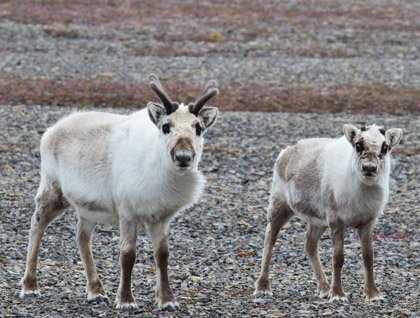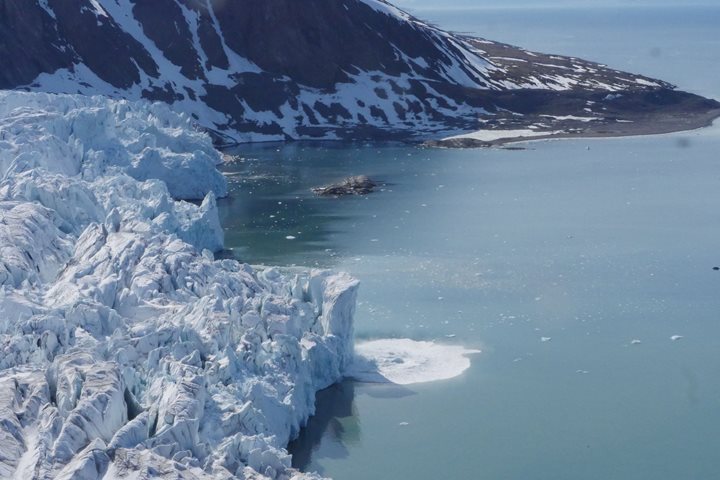Today turned out to be a great day for hiking and wildlife viewing! We woke up to a windy morning as National Geographic Explorer was cruising northwards along the southwestern coast of Spitsbergen. The captain found a sheltered anchorage at Van Keulenhamna, located by the mouth of Van Keulenfjorden.
After a good breakfast and a kayak briefing, medium and short hikes or an optional Zodiac cruise were offered. Some guests climbed steep hills onto a plateau with spectacular views while others walked the flat tundra. A little group of Svalbard reindeer seemed curious and showed up very close to some of the hikers. This location has very sparse vegetation, and we noticed reindeer feeding on the purple saxifrages that have just started to bloom, mostly in small patches on moraine material dominated by rounded stones and pebbles. The Svalbard reindeer is a subspecies of the reindeer on mainland Norway and is prone to eat almost anything that has leaves or roots. During the winter the reindeer are confined to feed on dry grasses and lichens, all with a very low nutrient value. However, thanks to a thick layer of fat that is built through intensive grazing during the short Arctic summer, most of the population manages to survive the harsh winter climate. The mortality rate through the winter is sometimes quite high, and we came across remains of reindeer that had found their last resting place on the windswept tundra (see photo). During the hike we spotted a great number of barnacle geese and a few pink-footed geese, some feeding on the flat wetlands while others were nesting on the cliffs. A few of the guests were also fortunate to spot an arctic fox running up and down the slopes hunting for food.
Just as many guests were slumbered into an afternoon nap, expedition leader Lucho announced on the A/V system: “We have a female polar bear with two cubs!” Many guests found their way to the front deck as the ship slowly approached by cutting through the thin ice. Through binoculars we noticed that the ice barely carried the weight of the adult bear. The ship stopped without getting too close, so the bears were out of reach for most of the camera lenses at hand. The naturalists could tell that the cubs were one and a half years old.
The rest of the afternoon was spent on the northern side of Bellsund, just off the mouth of Van Mijenfjord. A few guests then chose a Zodiac cruise, whereas the majority went ashore for a medium or short hike. The coastal belt on the north side of Bellsund is one of the most productive areas in Svalbard, with a relatively rich wildlife. Auks by the thousands nest in the scree slopes and cliffs above. The lush areas underneath the slope are fertilized by bird droppings providing rich nutrients for the vegetation that the reindeer and geese rely on. Some of the geese nest in the area, whereas most of those we saw were taking a break to “refuel” on their way to the northern parts of Spitsbergen Island. Seabird eggs and chicks constitute a good food basis for arctic foxes. A few of the guests were fortunate to get a glimpse of a fox as it was running around in search of food.
During Recap Lucho announced that we will head south to get around to the east side of Spitsbergen. The eastern parts of Svalbard archipelago generally holds more ice than the west side, so there is good reason to stay alert for more of those cream-white, furry things.







